
(Based on research by Neil Marchant)
* denotes church became United Reformed Church and **still in use as such
Clifton Down
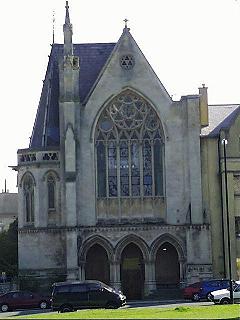 |
Began life in Bridge
Street, Bristol 1631 and possessed a licence.
Built above a wine cellar and suffered some persecution.
New building,1868, on a new site on the edge of the Downs
close to Christ Church, designed by C.F.Hansom better
known for his Roman Catholic churches. A very impressive building in French geometric style with a huge west front window and a three bay arcaded entrance below. The tracery of the side windows - bold and very geometric with excellent buttresses. Disappointing apse though. Inside there was an hammer beam roof. Sadly the interior all swept away when the building was converted into flats - gone are the roof and south side of church - not the best of conversions but at least some of it remains. Planned tower and spire as Bryan Little says was never built. |
Penn Street Chapel - see Whitfield, Horfield
Castle Green, Greenbank**
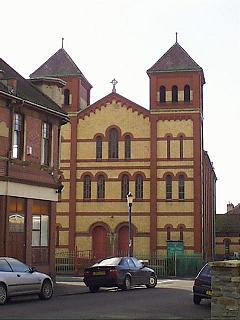 |
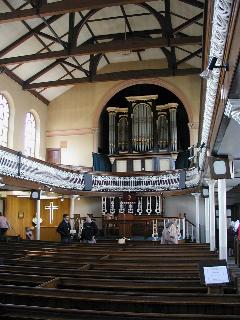 |
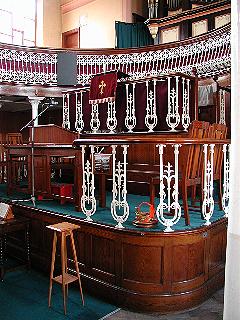 |
Replaced a classical church in Castle Street in central Bristol. The Congregation was founded in the 17th century. this new chapel was designed by Frank Wills in 1900 is in a German Robundesque style with two open work towers. Materials here are yellow and red brick. The interior had large galleries and an organ in a shallow recess. There were plans afoot in 2003 to reorder the interior but worse news followed in 2008 when the church held its final service. There were plans to sell the building, retaining the adjoining halls for community use and converting the church into flats. The congregation has now joined with the Mangotsfield URC in South Gloucestershire.
On a recent visit here I received a warm welcome (May 2003) and I was granted access to the archived history of the church. Remarkable are the survival of a few photographs of the original church in Castle Green. These are shown below. Note the white ironwork in the central photograph, and you will notice that this is preserved in the present church, in fact a couple of them are broken but the historian informs me that they have a few spare ones. This must be late Victorian as the picture on the far right (below) shows a different arrangement at the east end. The doorway to the original church is interesting too, and could be older than the church itself, possibly part of the late medieval city. All this was demolished after c1900.
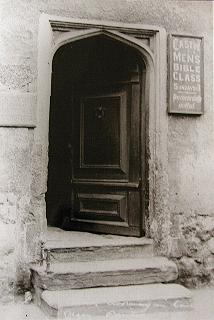 |
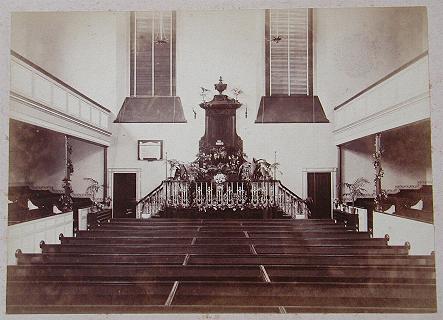 |
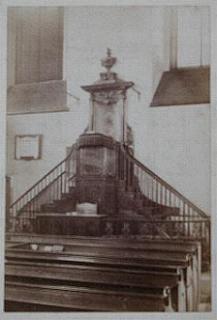 |
West Street, Bedminster**
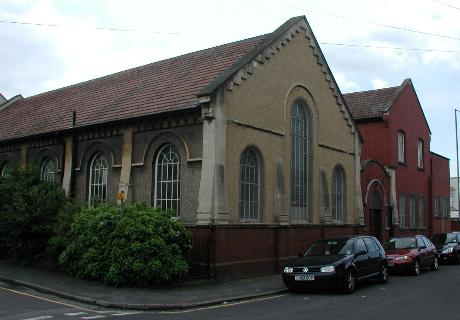 |
Founded in 17th cent. Present group of buildings include a vaguely Romanesque chapel (?) looking late C19, rendered with stone dressings, and a building of red brick which is presumably schoolrooms etc. of uncertain date, joined by an arched entrance. . | 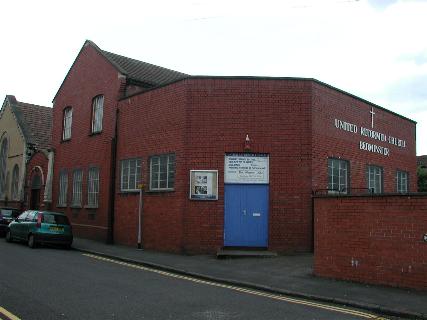 |
Gideon Chapel, Newfoundland Road
Opened in 1819 as a preaching station which was used by Congregationalists on an off and on basis. It was host to Rev Muller for a while to and his assistant Craik. A plain building with galleries, barrel ceiling and a east organ. Long since demolished for Newfoundland Road.
Welsh Church, Lower Castle Street/ St James Barton
Records show a Welsh congregation met in Bristol as early as 1639. Founded 1819 by Rev Lovell of Bridge Street for a Welsh speaking congregation. Chapel opened 1823 after originally meeting in Quakers Friars. Always small the church closed and re opened a couple of times. During World War Two the text on the east wall stated ‘prepare to meet thy God’ and the text of the sermon on Sunday 24th November 1940 was the same. No sooner had the preacher announced this than the sirens began, and by the time the sermon had finished bombs were falling. Most of the congregation sheltered in the cellars beneath, part of the medieval castle. Upstairs, their church burnt. Services moved to the schoolroom at Penn Street. The members then bought in 1957 the premises of St James Presbyterian. This was built in 1859 and was also bombed. The Welsh Church kept the tower (but the tall elegant spire was later removed) and lower west front doors by J.C Neale in dagger tracery as a boundary wall. The new church was set back behind a courtyard by Eustace Button. It had a modern interpretation of a classical chapel with the old chairs and pulpit from Castle Street. Tip up seats - Hall was lancet in style and backed on to it. Chapel closed 1988 and halls plus the modern chapel were demolished. Ugly bad taste office block badly massed against the surviving old tower.
Zion, Bedminster (The Church of the Vow)
| Fantastic classical building begun on May 12th 1829 and opened 15th June 1830, funded by John Hare an affluent merchant in fulfillment of a vow made when he came to Bristol in 1773 to make his fortune. Dominant position on Bedminster Bridge with a pillared portico and pediment and sashed windows. Plainer on the side. Interior quite Greek with galleries on Ionic columns and east organ. Nice ceiling. David Thomas was a minister here. Hare was buried in the chapel but reinterred in Arnos Vale. The church closed in the 1980’s with only 12 members . Excellently restored (although the interior was lost) as a Neighbourhood Housing Office for Bristol City Council although the rather nice ministers manse was lost. | 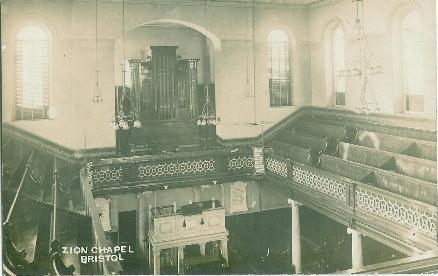 |
Brunswick Chapel, St Pauls
1834 by William Armstrong . A very well detailed classical building with a flat pediment and in ashlar with sashed windows. It was damaged by bombing in the Second World War, on the24th November 1940, again on 2nd December 1940 after which much work was done to repair the church for reopening but fell victim again to a raid on 16th March 1941. Long since closed and now excellently restored as an office building along with manse.
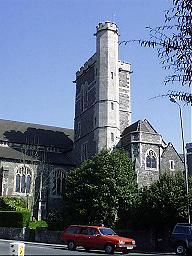 |
Paid for by the Wills Brothers. 1843 on the site of the burning of the Protestant martyrs. Designed by William Butterfield and his first commission. Regretted it after as it was his first building. Apse and tower by Godwin 1863 who later designed carriage works in Stokes Croft. F Wills rebuilt the apse in 1893. Damaged in Air Raid early 1941, repaired and reopened April 1944. Closed 1972 and became the Church of England parish church of St Saviour & St Mary, Cotham. |
Arley Chapel, Montpelier
| Built 1855 paid for by unknown benefactor who only asked that it be named after a village in Worcestershire. Designed by Foster and Wood in their characteric style as at Kingswood Moravian. The building has a almost debased baroque feel to it. Cruciform with a west end with circular portico and a distinctive wooden bell tower on top. The transepts have venetian style windows. The interior roof is a rather nice folded ceiling springing from the side walls with a clerestory above. At the east is a plain apse. Pews remain in three rows. Organ rebuilt. Church bought by Polish R.C to whom it is suited and renamed Our Lady of Ostrabrama. Congregationalists moved to Christ Church, Cotham with the Baptist and Methodists in 1960’s but that has since closed. | 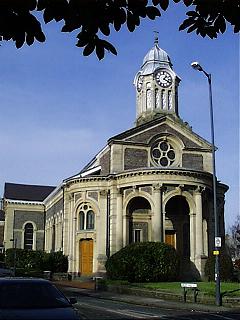 |
Redland Park** (revised entry with thanks to research by Andy Foyle)
|
Built by Fripp and Ponton 1860-1 in a Decorated gothic style with a tall tower and spire of unusual outline and rather Germanic-looking. Clerestory and chancel with fine fittings. The arcades were rather thin and the piers stood on tall bases. Sculptured reliefs in quatrefoils in the spandrels. It aroused much criticism due to the lavish design, which included a very ornate east rose window above blank arcading. The colour scheme was also unusual with maroon brick patterning, blue-grey walls and "richest chrome yellow" on the ceiling, "more 1960 than 1860" (A Foyle). Bombed December 1940 and replaced by a rather fine simplified gothic building in 1955-57 by Ralph Brentnall without a tower. New church also cruciform has a four manual organ with 79 stops. |
|
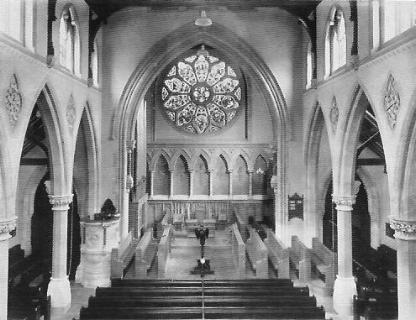 |
Pre-war and post war interiors looking east. | 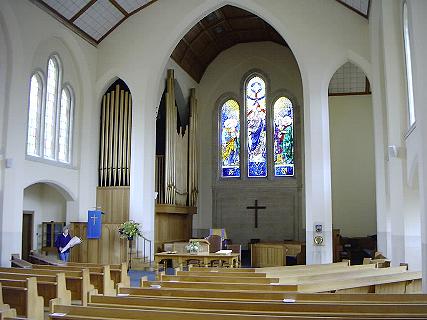 |
Pembroke Road Chapel, Clifton (revised entry with thanks to research by Andy Foyle)
| The first church on this site "created to lessen the walk to other chapels" was a "tin tabernacle" of 1866, painted to look like stone and with a spire reaching approximately 55ft. The present cruciform church is by W.H.Hawtin 1877. Large west window in geometric gothic with side lancets and a rather nice timber ceiling. Closed 1930’s, became a garage and then tastefully restored as office space (date?). | 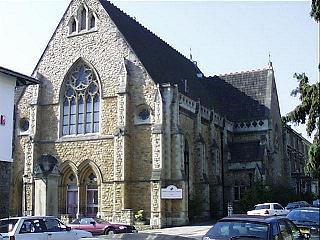 |
Stapleton Road, Easton
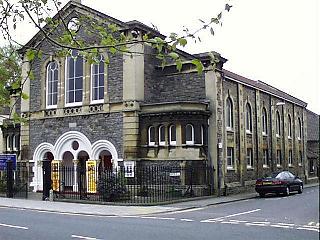 |
Large Bristol Byzantine building 1867 still Congregational not U.R.C. Rather an original work - and rather large, six bays in total with a western entrance vestibule with continuance of the gallery above which runs around all four sides, although the organ is in a recess. Metal pillars, including above the galleries carrying wooden arches to support the roof. | 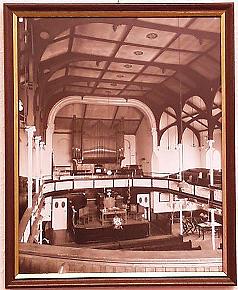 |
Russell Town, Lawrence Hill
Substantial 1868 gothic with apse and large west window. Closed, and demolished ? c1976. Now replaced by 1950’s combined church on a different site in Ducie Road.
Barton Hill
Stood in Days Road and was built in 1882 with support from Pembroke Chapel Clifton (see above). It had started in Charlton Hall in 1873. The church recieved a splendid pipe organ from Pembroke Chapel when it closed.
Christ Church, Sneyd Park
| Built 1877 and designed by Stuart Coleman. Similar in elements to David Thomas Memorial church, Bishopston. Substantial but thin tower and spire, tall slim windows in the clerestory and gothic meeting rooms behind church. Wooden rib vault interior. All sadly demolished in 1961. | 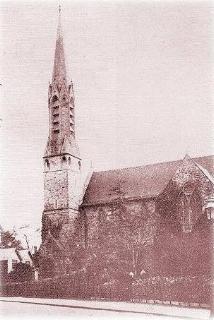 |
David Thomas Memorial Church, Bishopston*
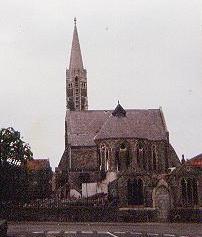 |
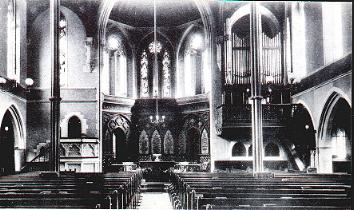 (left) Demolition starts revealing a view of the apse once hidden behind the church halls. |
Founded 1878 in memory of minister at Highbury Chapel. Vast gothic church halls built first with spikey tracery and bay windows. The church was built 1879 - 1880. Architect Stuart Coleman - who had designed the magnificent Pavement Unitarian Church, Nottingham and also Christ Church Sneyd Park. Huge church with dagger tracery and a tower with octagonal top and spire, highly original. The nave had three massive cross-gabled bays with rose windows and huge buttresses. Interior had four rows of arcades. The main part of the church had wooden rib vaults and circular piers. At the east was a tall apse with organ gallery. Glass by Ernest Board, a church member who did the painting now in St Nicholas Church Museum. Church repewed 1930’s. The church membership had dwindled post-war and due to dry rot and the small congregation the building was sadly closed 1981. In 1986 work was started pulling it down for flats by Stride Treglown who have kept the steeple and west front and allegedly the shape of the old building.
Kingsland Chapel, St Philips
| Recent Email correspondance from Mr
David Dawson has meant changes for this entry. Featured
here were buildings Neil believed were part of Kingsland
Chapel, but according to Mr Dawson was a Mission Chapel
from St Silas church on Feeder Road. This original entry
is preserved below until such time as a page on St Silas
is completed. Mr Dawson kindly sent his picture of Kingsland Chapel taken in 1976, the church already in a poor state, and indeed it was demolished in 1980. The building is almost certainly the original one of 1836. The Dings was a complicated area with a proliferation of chapels and churches. Indeed close by was the Anvil Street Chapel (below), another Congregational foundation I believe from Highbury Chapel. |
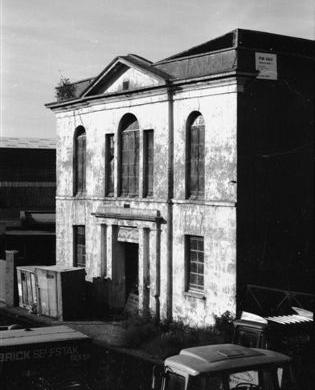 |
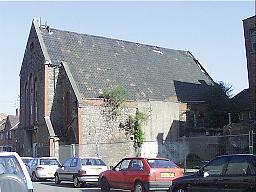 |
St Silas Mission Chapel Built in late 19th cent. in Union Street, closed by 1935. The building is a lancet church with remains of a former turret over the west gable and in grey pennant stone with red brick dressings. West end three lancets,east end also stepped triplet and two slightly lower placed outer single lancets. For many years it was used as a garage and was in a very precarious state of repair in March 2005 but the building has since been restored. Situated behind the very grand Shaftesbury Crusade buildings, built as a temperance mission with terracotta details, towers, clockface and rooms. Founded by Ernest Tribe of Redland Park Congregational church, moved to another Quaker school in 50’s and recently closed although male voice choir continues at Airballoon Road Methodist. |
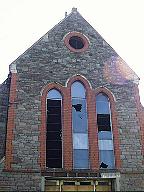 |
Anvil Street Chapel
| Opened in 1834 and largely run
under the care of Highbury Chapel. In the early 1890s the
church joined forces with Broad Plain Mission, and from
this Broad Plain Lads' Club was born. Broad Plain Rugby
Club was founded in 1909 andmoved into the Anvil Street
premises and the chapel became their gymnasium. The club
moved to purpose-built premises in Clement Street, Easton
in 1985 and any remaining buildings in Anvil Street were
demolished in 1986. It is unsure if the chapel survived
until then - any further information gladly received). A
new United Reformed Church at Brentry is
named after this church ‘New Kingsland.’ [Picture from David Dawson and used with permission.] |
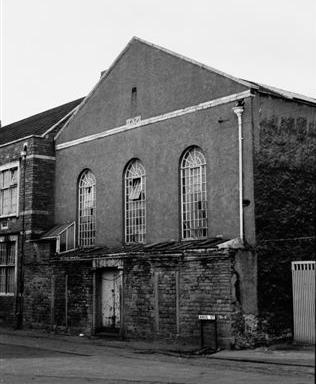 |
Morley Church, Lodge Causeway, Fishponds
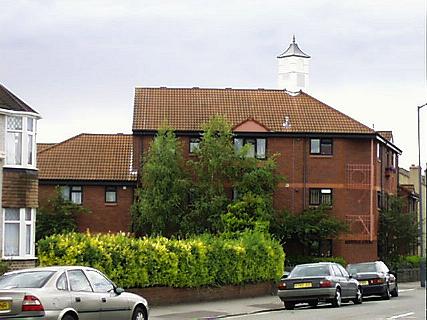 |
Built 1889 and named after Samuel Morley M.P. for Bristol 1868 - 1885. It was a sizeable cruciform building designed by congregationalist Frank Wills in his typical style with lancet windows and seated 400 people. Triple lancet west front and side single lancets. There was a gallery inside. By 1970 the church had severe structural problems which the congregation did not have the funds to put right and so the members met with Argyle Congregational (see below) in 1970 and were invited to join with them. Demolished and now replaced with flats (left), but was the odd little turret once part of the church? |
Brislington**
| A license was granted for worship in 1796 for dissenters and an independant church was established in a small building in the village. This chapel was rebuilt in 1827, and was called Zion Chapel. By 1883 it was known as the United Christian Church. The building was destroyed by fire in 1894. in 1898 the members of the church decided to join the Congregationalists and the foundation stone was laid on January 1st 1901. It opened in the following October. The church is seven bays long with two-light side windows and ugly plate traceried windows in the main front which culminated in a double bellcote. The church had a narrower east "sanctuary" and a SE organ loft. The interior sub-divided with church on the upper floor and a hall below, c1980. Stairs were created in the east end and the window with stained glass of c1930 now lights the stairwell. The organ chamber was blocked off. The west gallery still forms a raised bank at the western end of the church. Tall steeply-pitched roof rests on short shafts with foliated corbels and capitals. the most unusual feature is arguably the lift (elevator) in the second bay south, giving access to the frail and infirm to the church above. | 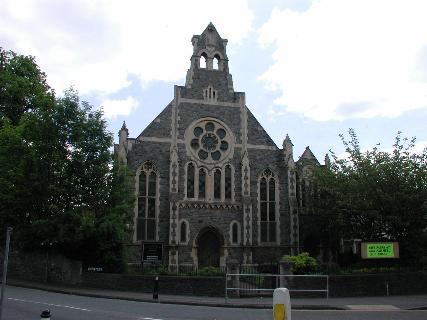 |
Henleaze**
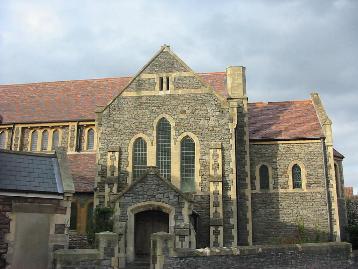 |
Rather nice church of 1906. Previously the church had met in the old halls. New church is a lancet cruciform building with an apse. Did have a tower planned but only one stage built. Designed by Frank Wills it has nice height inside with clerestory circular piers and a wooden barrel vault. Very spacious with aisles and organ chamber. | 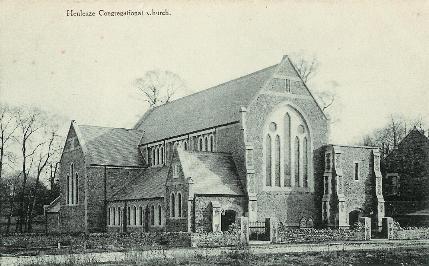 |
Avonmouth, Port View Road
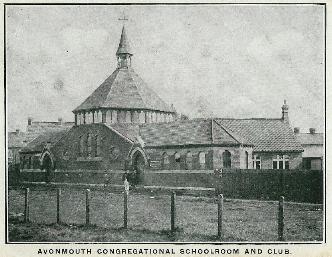 |
The first church was an unusual
complex of buildings with an octagonal lantern tower
carrying a small fleche. Opened in 1883, the architect
was a Mr Foster. The new building was erected 1902, designed by Sir George Oatley in an Arts & Crafts Gothic with a small tower, in Napier Road. I am unclear whether this was on a new site or alongside the old buildings or indeed whether these were demolished for this new church. Demolished 1972. |
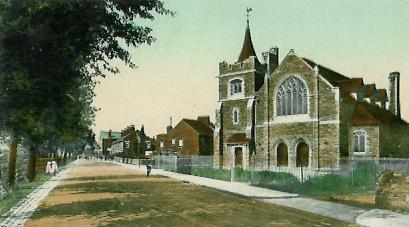 |
Totterdown (Windsor Terrace)*
"Uncommonly ugly with a few cum-Norman details in places" (1972 - Phil Draper's notes!)
Knowle Park*
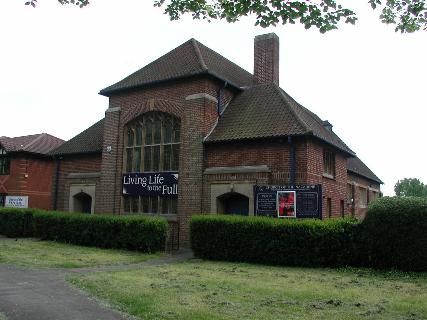 |
Built 1930’s gothic Arts & Crafts Perp with good west window. Now The Church of the Nazarene, a Pentecostal church in the Wesleyan tradition. |
Whitfield Tabernacle, Muller Road, Horfield**
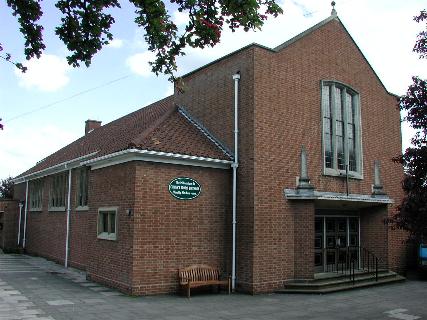 |
A deceptively fascinating chapel
built 1957 in a vaguely gothic style and shape to the
designs of Eustace Button. Named Whitefield Tabernacle,
it was the successor to the 18th cent Penn Street
Tabernacle demolished in new centre development
(site now occupied by C&A and the traffic lanes of
Bond Street). This new church is fifties gothic but
inside it contains a host of treasures from Penn Street -
a huge plaster Double-Decker pulpit with twin stair
cases, an 1815 organ with towered classical case - a very
superior instrument and a set of pews. The church has
recently been re - ordered for business at the east end
weekdays and pulpit brought forward. Alongside by the crossroads is the former church of 1933, now used as a hall. |
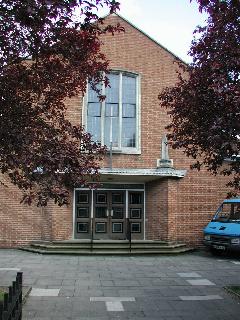 |
Argyle, Fishponds**
A late arrival into the Congregational Church in 1958, although had existed since 1895. The present building in Whitfield Road was begun in 1898 and opened in April 1899. The architect was A E Longden and the building is of red brick with terracotta dressings. There were extensions in 1925 and again in 1985 when the new porch was built. The church is today "Argyle Morley United Reformed Church".
The following are just outside of the city boundary
Hanham Tabernacle (South Gloucestershire)**
| Founded 18th cent by Whitfield. Rebuilt in 1840 (date surrounds the west wheel window), remodelled 1998. | 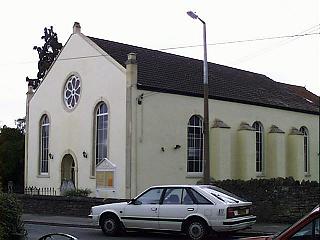 |
Staple Hill (South Gloucestershire)**
Nice lancet church of 1893. All one cell with single lancets. Nice feature is the hipped roof - unusual on gothic chapels. Designed by Frank Wills of the tobacco company family - all Congregationalists. Chapel closed 1998 with congregation of four. It is now a office building.
Long Ashton (North Somerset)
Built 1893 to the designs of Frank Wills in his characteristic style. Nice west wheel window and porch - rest lancets. High site. Interior gothic furnishings with a organ. Closed 1998 and now converted into residential usage.
Zion, Whitchurch (Bath & North-East Somerset)**
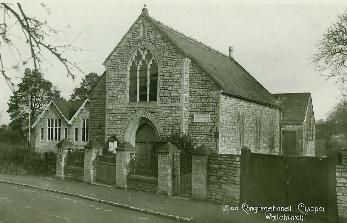 |
Simple little Gothic chapel on the main A37 road through the village. |
Back to Bristol churches Index
Page updated 19th June 2012